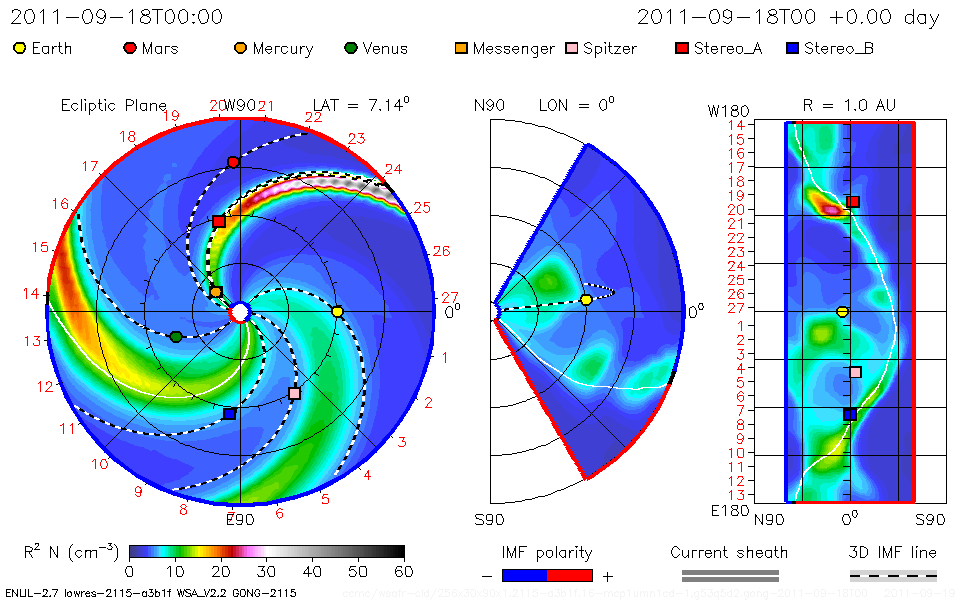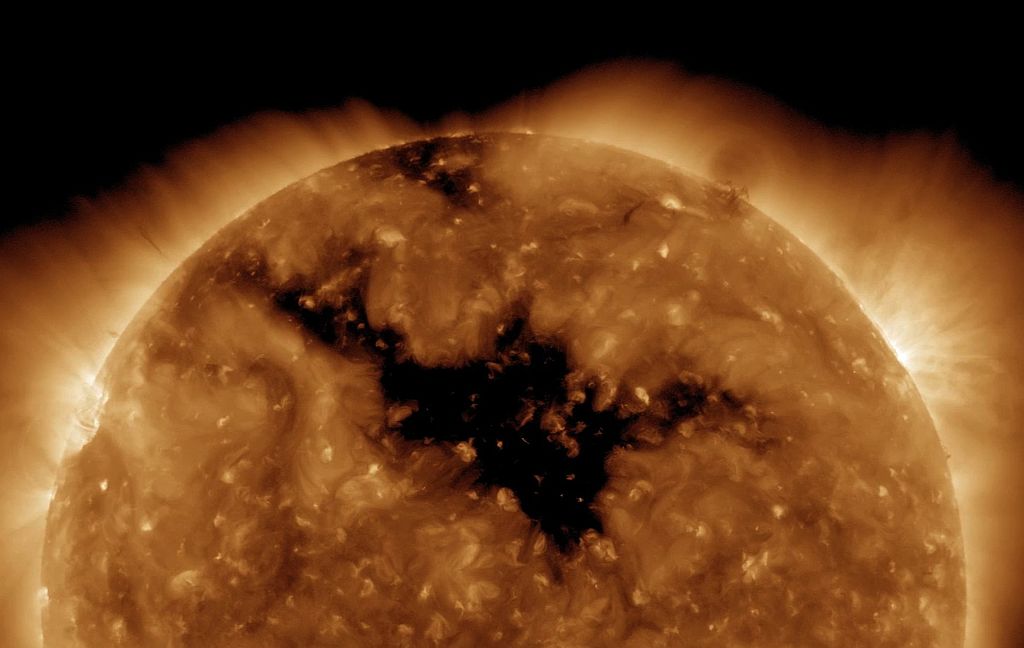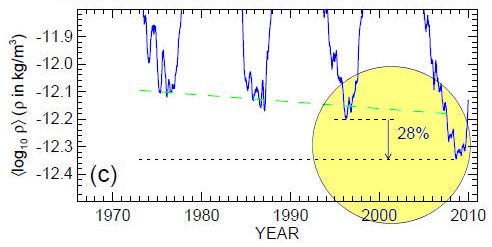APOD has a spectacular video of a comet impacting the Sun followed by a coronal mass ejection.
Rocket Science
The Sky is Falling
Here’s the latest report from NASA regarding UARS, the enormous satellite that will re-enter Earth’s atmosphere sometime today or tomorrow.
NASA’s Upper Atmosphere Research Satellite, or UARS, is expected to re-enter Earth’s atmosphere late Sept. 23 or early Sept. 24 Eastern Daylight Time, almost six years after the end of a productive scientific life. Although the spacecraft will break into pieces during re-entry, not all of it will burn up in the atmosphere.
The risk to public safety or property is extremely small, and safety is NASA’s top priority. Since the beginning of the Space Age in the late-1950s, there have been no confirmed reports of an injury resulting from re-entering space objects. Nor is there a record of significant property damage resulting from a satellite re-entry.
It is still too early to say exactly when UARS will re-enter and what geographic area may be affected, but NASA is watching the satellite closely and will keep you informed. Visit this page for updates on the satellite’s orbital track and predicted re-entry date.
Update #10
Fri, 23 Sep 2011 07:45:08 AM MST
As of 10:30 a.m. EDT on Sept. 23, 2011, the orbit of UARS was 100 miles by 105 miles (160 km by 170 km). Re-entry is expected late Friday, Sept. 23, or early Saturday, Sept. 24, Eastern Daylight Time. Solar activity is no longer the major factor in the satellite’s rate of descent. The satellite’s orientation or configuration apparently has changed, and that is now slowing its descent. There is a low probability any debris that survives re-entry will land in the United States, but the possibility cannot be discounted because of this changing rate of descent. It is still too early to predict the time and location of re-entry with any certainty, but predictions will become more refined in the next 12 to 18 hours.
Solar CME Animation
This is an interesting animation showing a three-axis presentation of recent solar coronal mass ejections. You can click on the image for the full-sized animation.
From SpaceWeather.com:
FOUR CMEs: On Sept. 19th, the STEREO-SOHO fleet of spacecraft surrounding the sun detected six coronal mass ejections (CMEs). Two of the clouds rapidly dissipated. The remaining four, however, are still intact and billowing through the inner solar system.
According to analysts at the Goddard Space Weather Lab, who prepared the movie, one CME should hit Mercury on Sept. 20th at 05:40 UT while another delivers a glancing blow to Earth’s magnetic field on Sept. 22nd at 23:00 UT. All impact times have an uncertainty of plus or minus 7 hrs.
Formation of Sun Spot 1130
The latest sunspot (number 1130) formed suddenly over the past two days. The image at the right shows the two day period in time lapse. You can see the spot forming in the top hemisphere just above the solar equator. You can see the full sized video here.
This winter, according to several AGW skeptic blogs and websites, promises to be quite cold. Our experience in Southern California over the last fifteen days is reported to be the record coldest for this period – and it’s not even winter yet.
I guess the lackluster return of solar activity in the solar cycle has contributed to the cold weather. We have written several articles over the past few years that show how the Sun affects global climate. Two important ones are:
In the latter article, I listed some conclusions about the climate change scam:
- The media will print or broadcast sensationalized headlines to sell copy regardless of scientific value
- The media will print or broadcast manipulated science with half-truths and invalid conclusions to damage politicians with whom they do not agree
- Politicians seize on these unverified claims in order to blame their opponents
- Uneducated/uninformed people are as gullible as ever
Unfortunately, even after Climategate, these conclusions still are valid.
Solar Eclipse as Seen From SDO
 An Interesting eclipse occurred earlier this month when the moon passed between the Solar Dynamics Observatory and the Sun. This is the first recorded lunar/solar eclipse taken by SDO although earth/solar eclipses happen often. SDO is like the Hubble Space Telescope but is totally devoted to solar activity.
An Interesting eclipse occurred earlier this month when the moon passed between the Solar Dynamics Observatory and the Sun. This is the first recorded lunar/solar eclipse taken by SDO although earth/solar eclipses happen often. SDO is like the Hubble Space Telescope but is totally devoted to solar activity.
The image at the right shows the partially-eclipsed solar disk (courtesy NASA – click to enlarge). I also uploaded a close-up image in which the mountains along the lunar limb can be discerned against the solar disc. This demonstrates the excellent resolution of the instruments aboard SDO.
The following is taken from the SDO website where you can download and watch a Quicktime video of the eclipse.
This was a first for SDO and it was visually engaging too. On October 7, 2010, SDO observed its first lunar transit when the new Moon passed directly between the spacecraft (in its geosynchronous orbit) and the Sun. With SDO watching the Sun in a wavelength of extreme ultraviolet light, the dark Moon created a partial eclipse of the Sun.
These images, while unusual and cool to see, have practical value to the SDO science team. Karel Schrijver of Lockheed-Martin’s Solar and Astrophysics Lab explains: “The very sharp edge of the lunar limb allows us to measure the in-orbit characteristics of the telescope e.g., light diffraction on optics and filter support grids. Once these are characterized, we can use that information to correct our data for instrumental effects and sharpen up the images to even more detail.”
A Giant Hole in the Sun
Speaking of solar activity, a giant coronal hole opened up in the Sun’s northern hemisphere earlier this week, triggering auroras at high latitudes. Image made by the Solar Dynamics Observatory (SDO), via APOD. Click image to enlarge.
The Sky is Falling
Just wait for all the Chicken Little types to try and blame this obviously solar-related phenomenon on Anthropogenic CO2 production. From NASA Science:
A Puzzling Collapse of Earth’s Upper Atmosphere
July 15, 2010: NASA-funded researchers are monitoring a big event in our planet’s atmosphere. High above Earth’s surface where the atmosphere meets space, a rarefied layer of gas called “the thermosphere” recently collapsed and now is rebounding again.
“This is the biggest contraction of the thermosphere in at least 43 years,” says John Emmert of the Naval Research Lab, lead author of a paper announcing the finding in the June 19th issue of the Geophysical Research Letters (GRL). “It’s a Space Age record.”
Image: Atmospheric Density over time.The collapse happened during the deep solar minimum of 2008-2009—a fact which comes as little surprise to researchers. The thermosphere always cools and contracts when solar activity is low. In this case, however, the magnitude of the collapse was two to three times greater than low solar activity could explain.
“Something is going on that we do not understand,” says Emmert.
Gee . . . Ya think?



